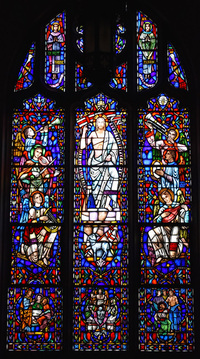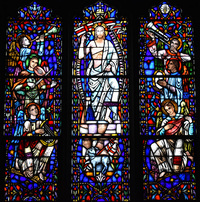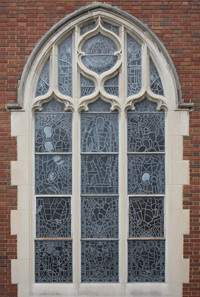Window
Building Name: First United Methodist ChurchStudio Name: Willet Hauser Architectural Glass
City: Birmingham
Window Shape: 6 (gothic arched, more than 2 vertical sections)
Date of Window: 1956
Subject/Title of Window: The Resurrection Window
Brief Description of Subject: This transept window is signed at the bottom "Willet Studios Phila., Pa, `56.
The following description from the book, "The Windows and Symbols of First Methodist Church Birmingham, Mich. edited by Dr. Arnold F. Runkel and privately published by the Church for its members in 1966.
THE RESURRECTION WINDOW
The theme of this window is the Resurrection of the Lord.
Dominating the center lancet is the figure of the Resurrected Savior stepping from the empty tomb, the clothes of the grave falling from His body. He is crowned with the tri-radiant nimbus that signifies the Divine Trinity and is surrounded by a vesica of light. He holds in His right hand the banner of the Church Triumphant. In the shield above His head is the Cross of Triumph, a small latin cross rested upon a banded globe, symbolizing the triumph of our Savior over sin in the world. At his feet is the Agnus Dei, bearing the banner of Victory, and surrounded by such symbols of the Resurrection as the Easter lily and the bursting pomegranate.
In the small predella below are the three Marys confronting the angel at the empty tomb. The words of the angel can be read in the tracery openings at the top of the window. 'He is not here; He is risen.'
Angels of praise playing ancient musical instruments such as the nevel (psaltery), harp of David, trumpet and horn, timbrel and viol, appear in the side lancets, which surround the figure of the risen Lord. In the shields of the lancet tops above their heads are further Resurrection symbols: the Phoenix, rising from the ashes, and the bee [disappears into the hive in the winter only to reappear in Spring].
Two post-Resurrection appearances of the Savior are depicted in the small predella medallions at the bottom of the window. To the left is the Supper at Emmaus and to the right, Doubting Thomas thrusting his hands into wounds of our Lord.
In the central tracery opening at the very top of the window is the Kingly 'crown of life', symbolizing that through the Resurrected Lord, we too have eternal life. The crossed palm branches beneath it denote Victory. There are two more symbols in the tracery openings. One, the Peacock, which sheds its brilliant feathers annually only to get newer and finer ones, symbolizes immortality through Jesus Christ. Finally we find that most explicit of all symbols of the Resurrection and of eternal life through Jesus Christ --- the Butterfly, the lifespan of which may be said to represent three stages of the Christian. First, the crawling larva represents the lowly condition of mortal man on this earth. Next, the chrysalis --- lying in its shell and seemingly lifeless --- symbolizes man's body in the grave. Finally, the pupa bursts its outer shell, emerges, dries its wings and soars heavenward with a beautiful new body. So, also, will our Lord raise up all the dead on the last day, when the soul and glorified body will be reunited, to dwell in Heaven forever.
The Resurrection Window was given by Mrs. James Dant.
The theme of this window is the Resurrection of the Lord.
Dominating the center lancet is the figure of the Resurrected Savior stepping from the empty tomb, the clothes of the grave falling from His body. He is crowned with the tri-radiant nimbus that signifies the Divine Trinity and is surrounded by a vesica of light. He holds in His right hand the banner of the Church Triumphant. In the shield above His head is the Cross of Triumph, a small latin cross rested upon a banded globe, symbolizing the triumph of our Savior over sin in the world. At his feet is the Agnus Dei, bearing the banner of Victory, and surrounded by such symbols of the Resurrection as the Easter lily and the bursting pomegranate.
In the small predella below are the three Marys confronting the angel at the empty tomb. The words of the angel can be read in the tracery openings at the top of the window. 'He is not here; He is risen.'
Angels of praise playing ancient musical instruments such as the nevel (psaltery), harp of David, trumpet and horn, timbrel and viol, appear in the side lancets, which surround the figure of the risen Lord. In the shields of the lancet tops above their heads are further Resurrection symbols: the Phoenix, rising from the ashes, and the bee [disappears into the hive in the winter only to reappear in Spring].
Two post-Resurrection appearances of the Savior are depicted in the small predella medallions at the bottom of the window. To the left is the Supper at Emmaus and to the right, Doubting Thomas thrusting his hands into wounds of our Lord.
In the central tracery opening at the very top of the window is the Kingly 'crown of life', symbolizing that through the Resurrected Lord, we too have eternal life. The crossed palm branches beneath it denote Victory. There are two more symbols in the tracery openings. One, the Peacock, which sheds its brilliant feathers annually only to get newer and finer ones, symbolizes immortality through Jesus Christ. Finally we find that most explicit of all symbols of the Resurrection and of eternal life through Jesus Christ --- the Butterfly, the lifespan of which may be said to represent three stages of the Christian. First, the crawling larva represents the lowly condition of mortal man on this earth. Next, the chrysalis --- lying in its shell and seemingly lifeless --- symbolizes man's body in the grave. Finally, the pupa bursts its outer shell, emerges, dries its wings and soars heavenward with a beautiful new body. So, also, will our Lord raise up all the dead on the last day, when the soul and glorified body will be reunited, to dwell in Heaven forever.
The Resurrection Window was given by Mrs. James Dant.
Inscriptions: He is not here
He is risen
Height: 15'
Width: 7'
The Resurrection Window
The Resurrection Window canopy
The Resurrected Savior surrounded by Angels of Praise
Supper at Emmaus, left; The Three Marys, center; Doubting Thomas, right
The Resurrection Window signature
The Resurrection Window outside
The MSGC is a constantly evolving database. Not all the data that has been collected by volunteers has been sorted and entered. Not every building has been completely documented.
All images in the Index are either born-digital photographs of windows or buildings or are scans of slides, prints, or other published sources. These images have been provided by volunteers and the quality of the material varies widely.
If you have any questions, additions or corrections, or think you can provide better images and are willing to share them, please contact donald20@msu.edu








